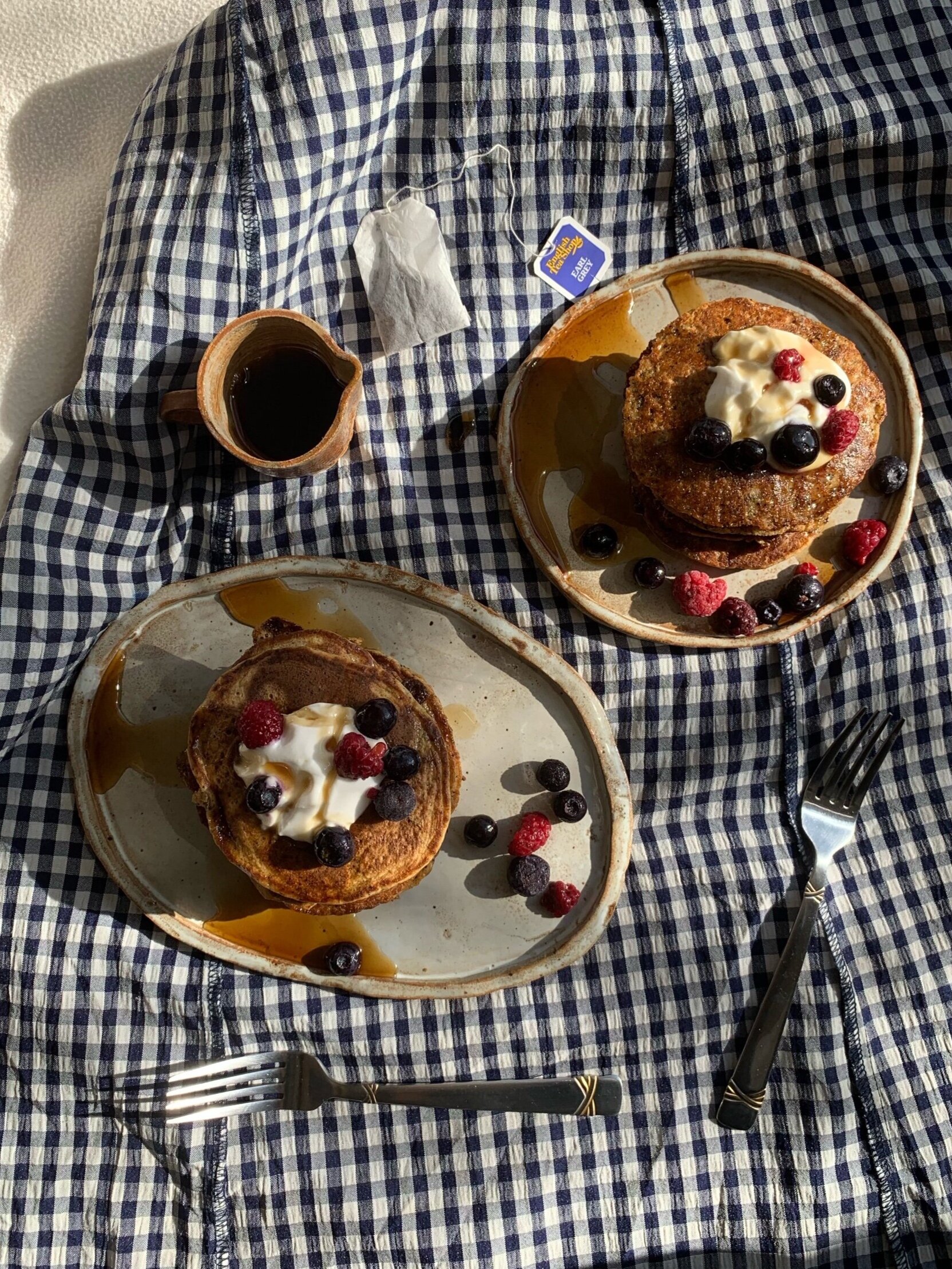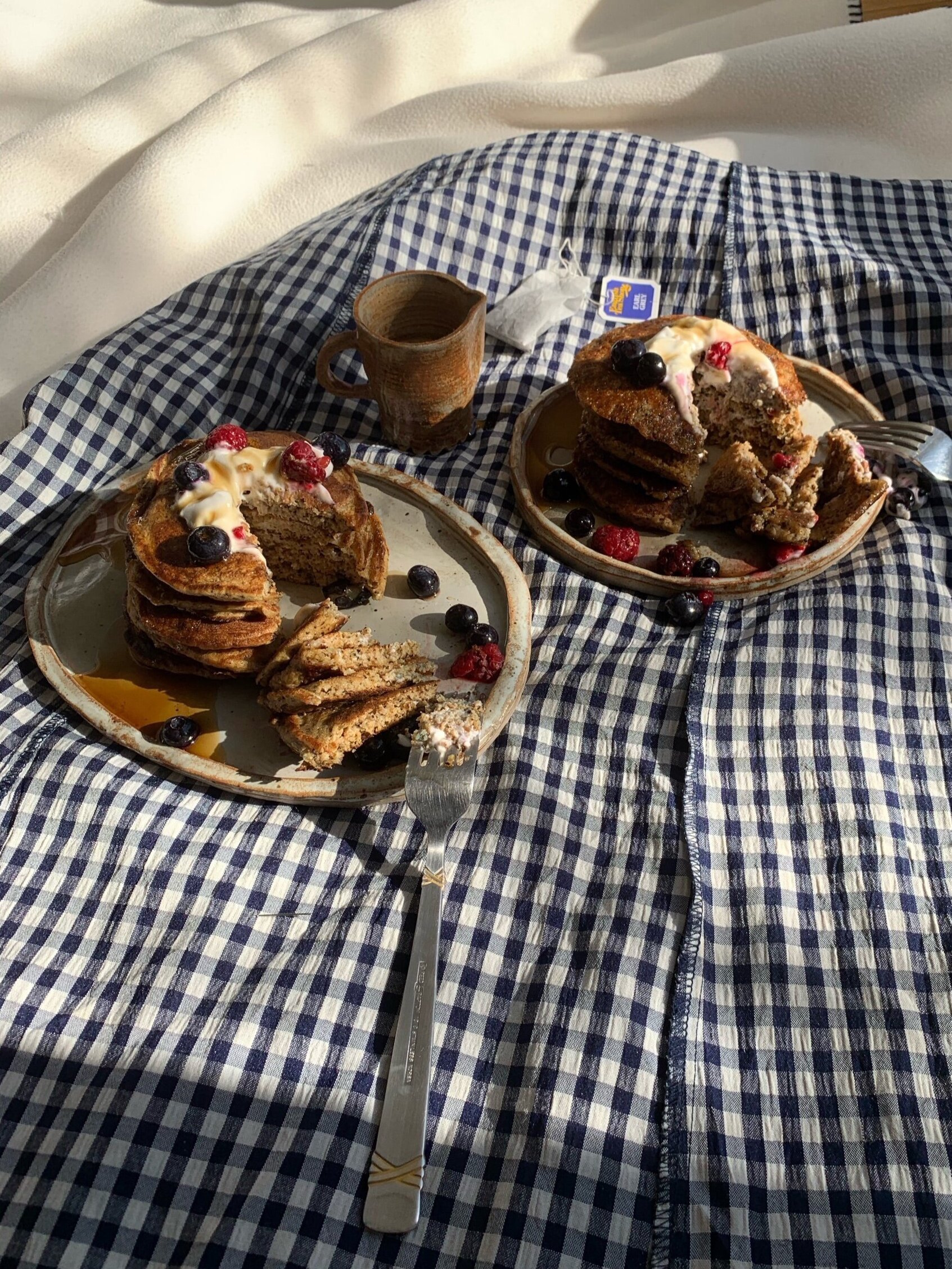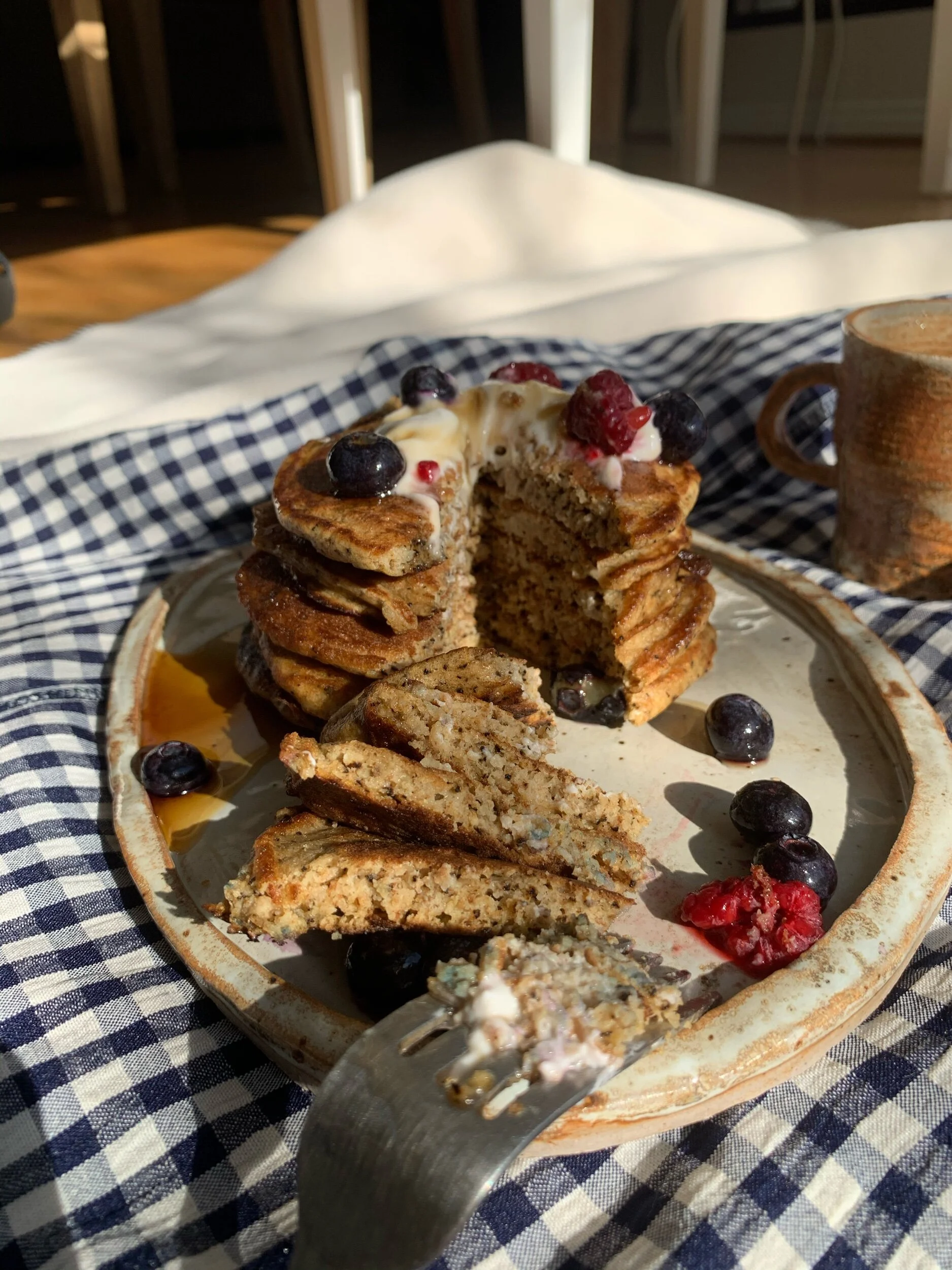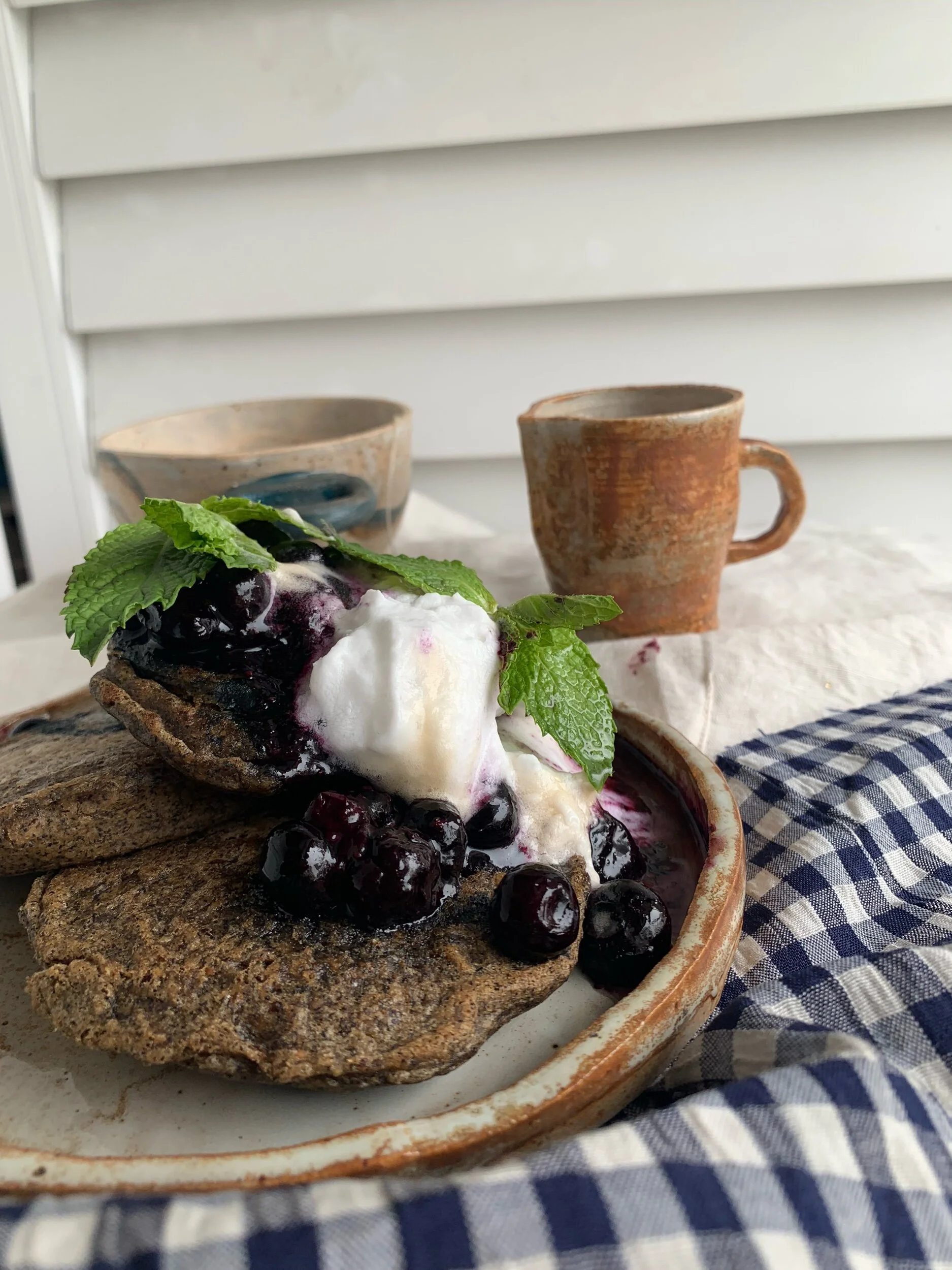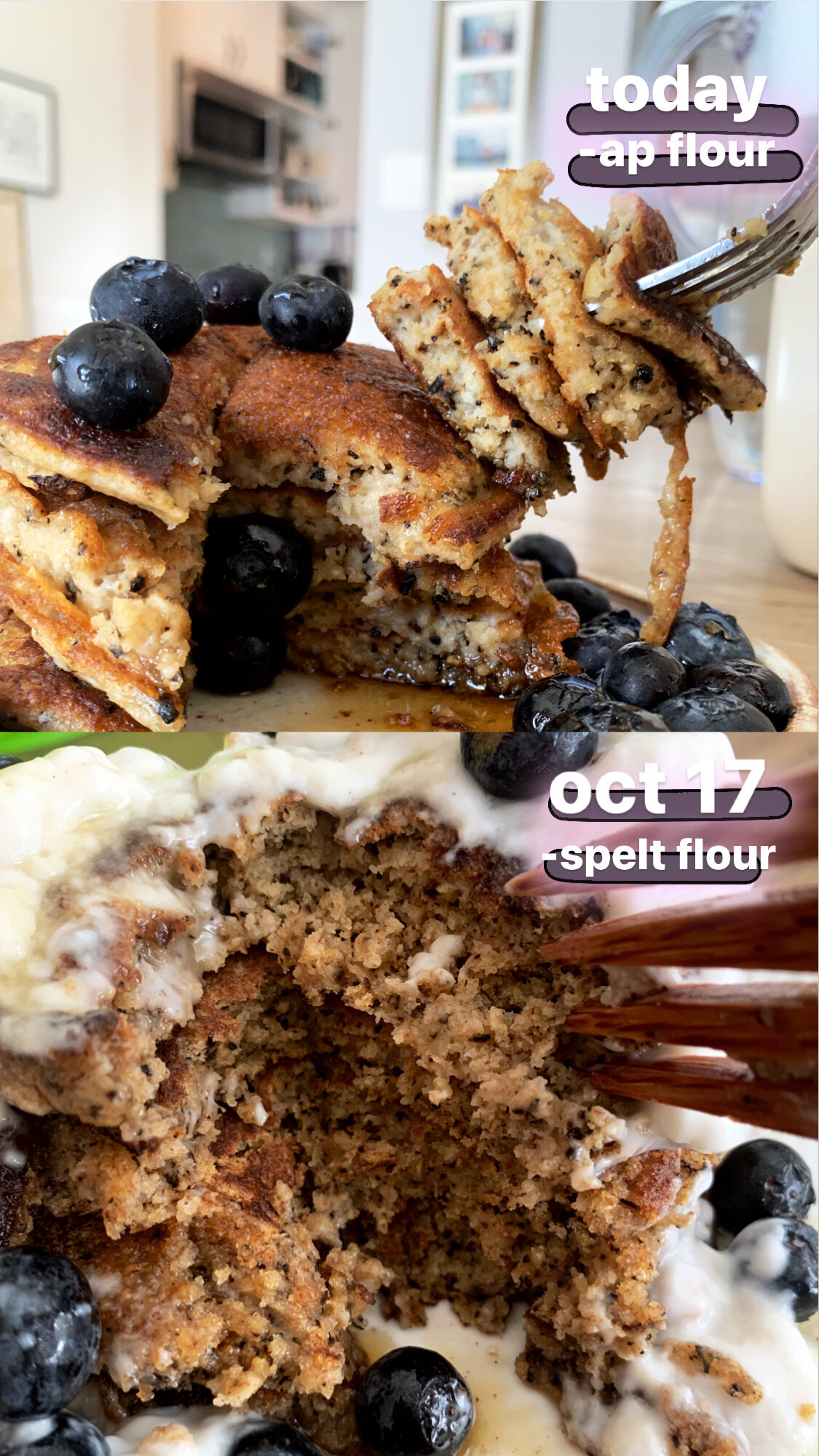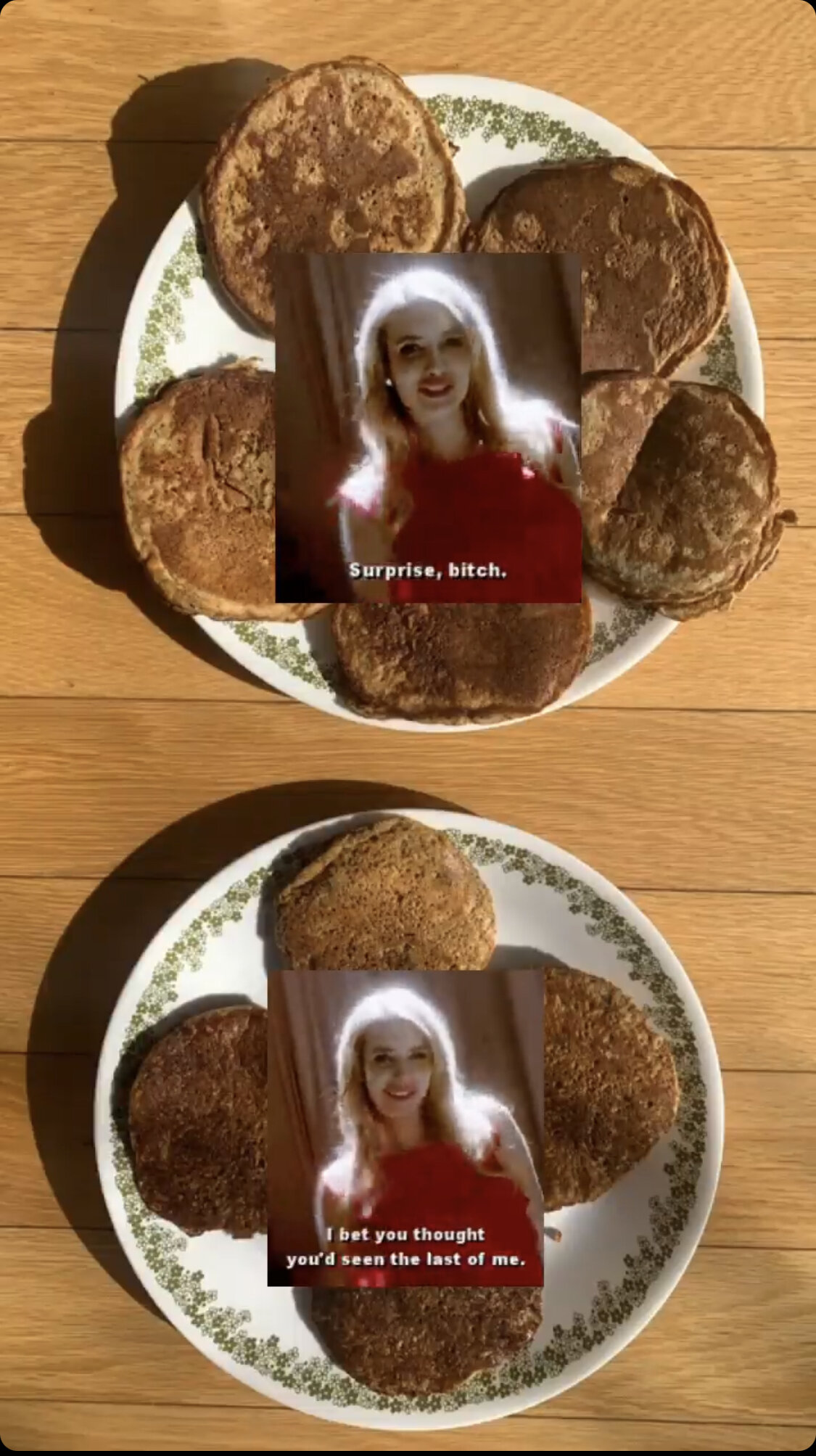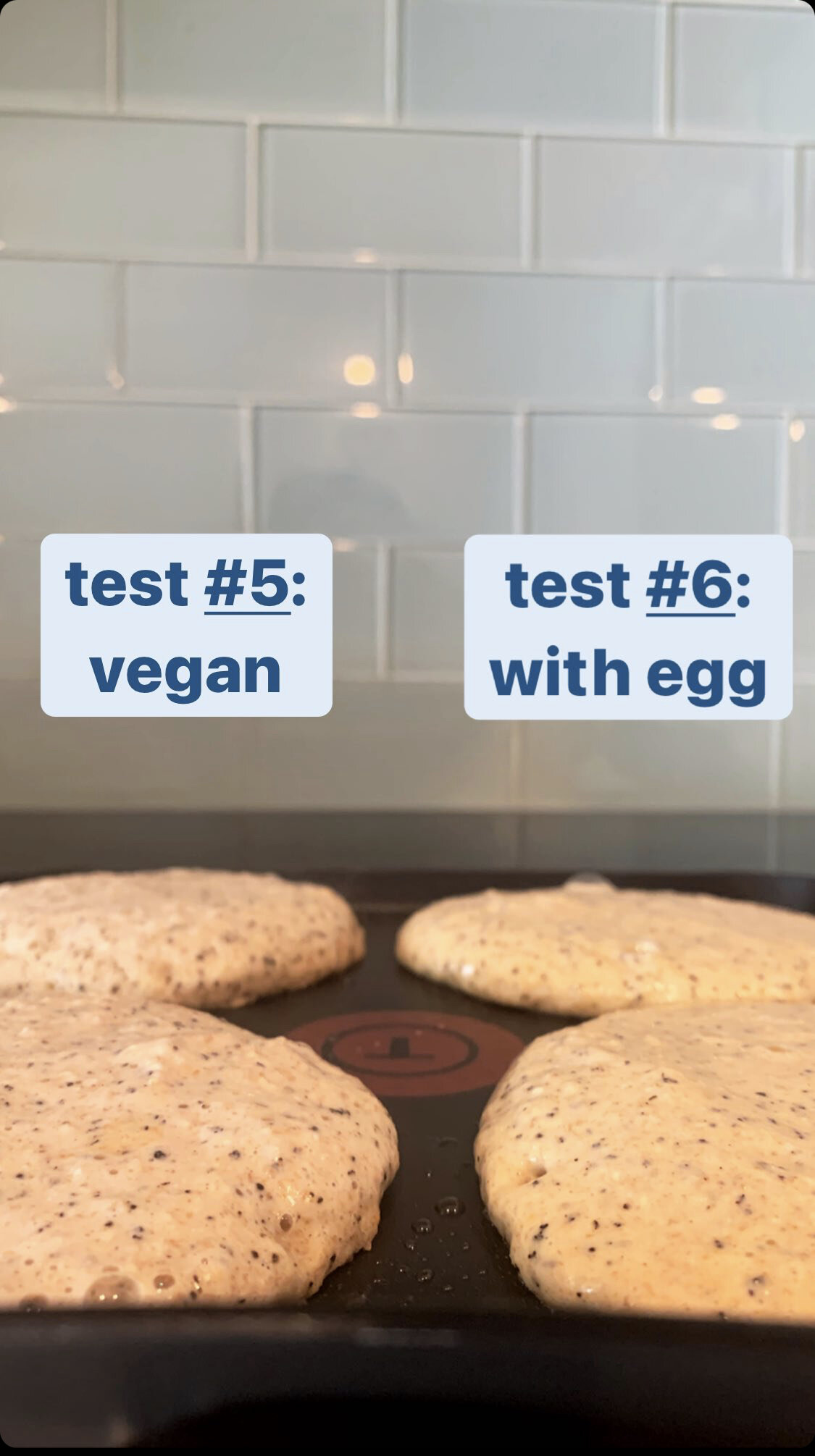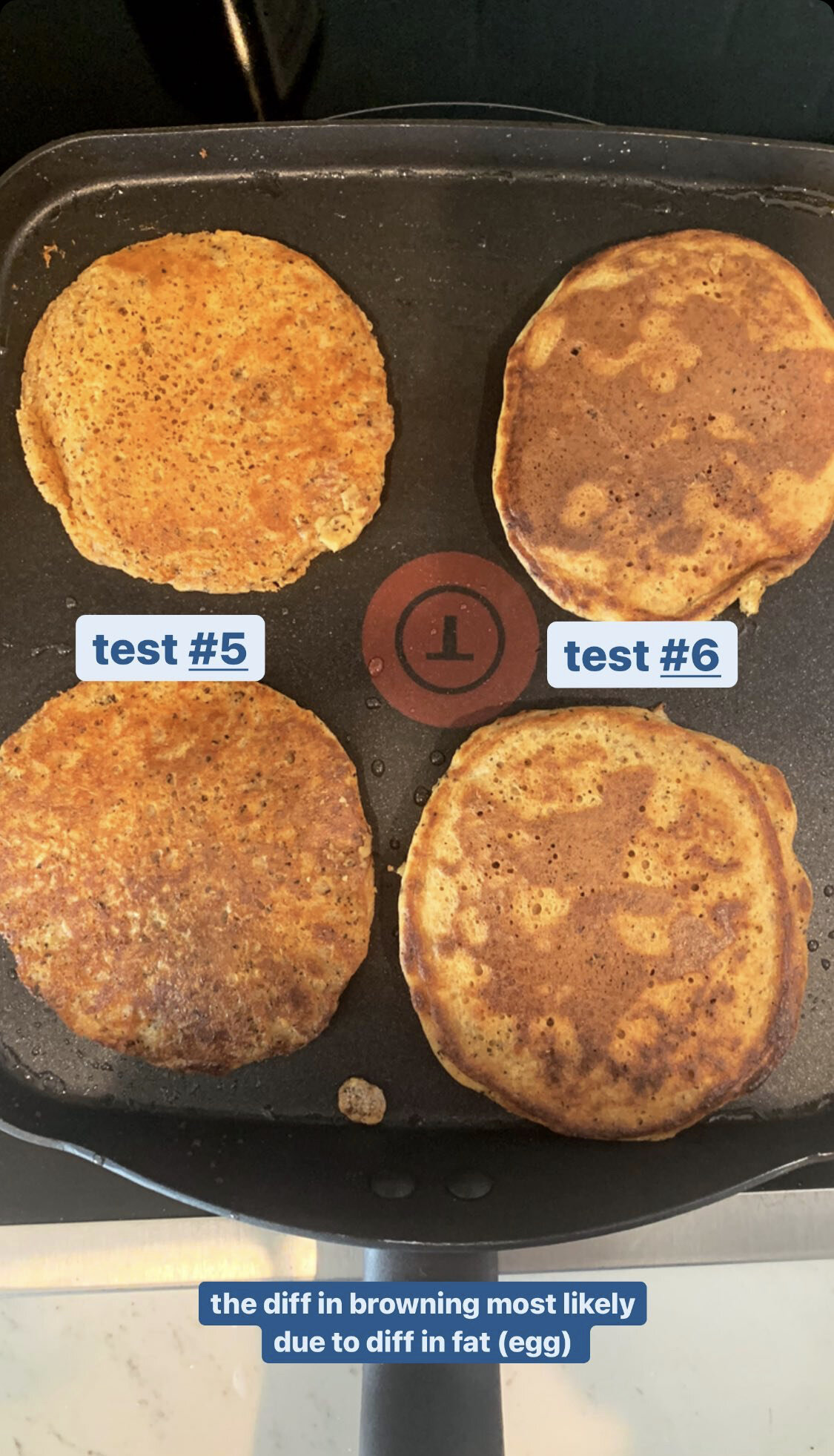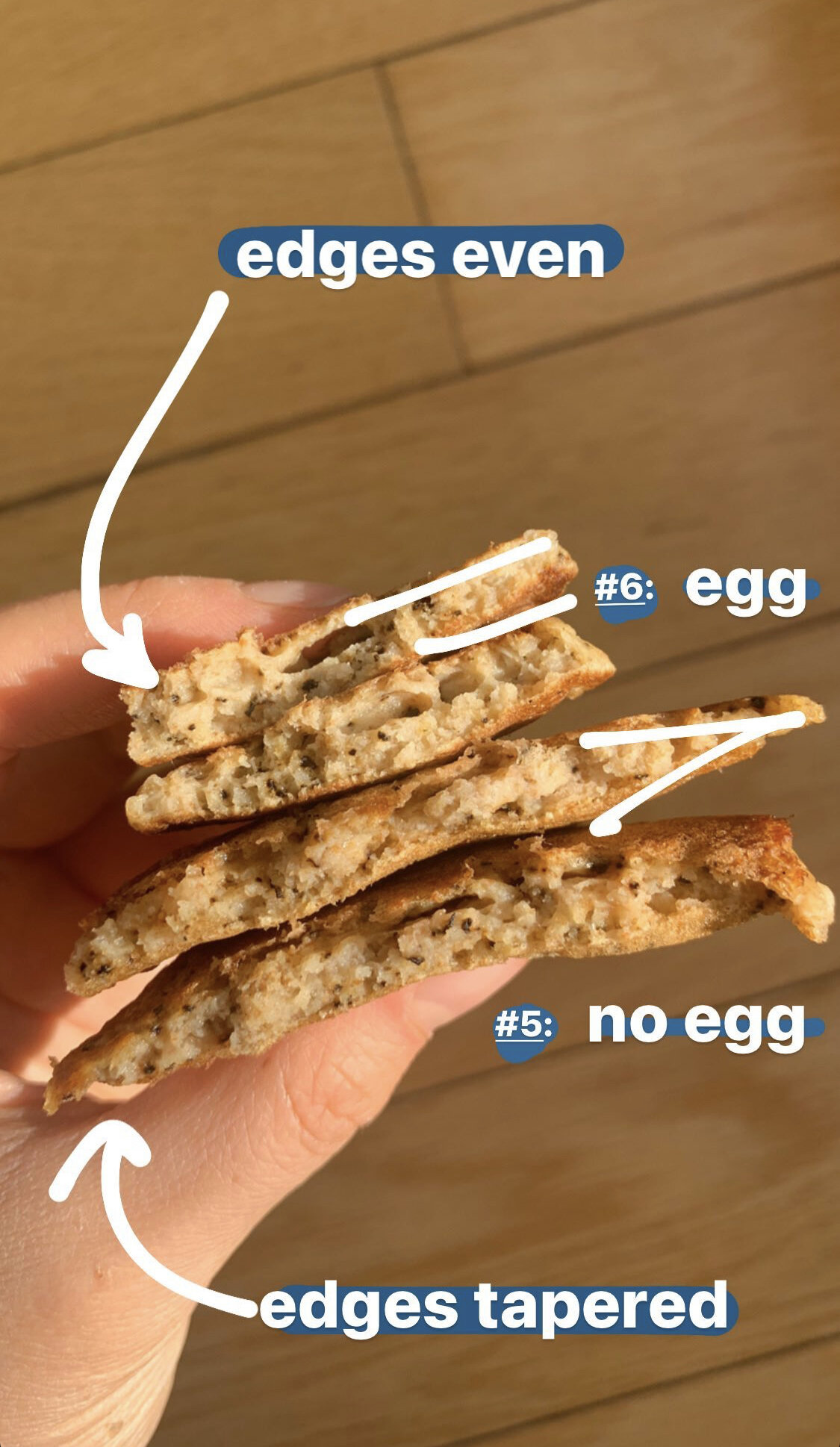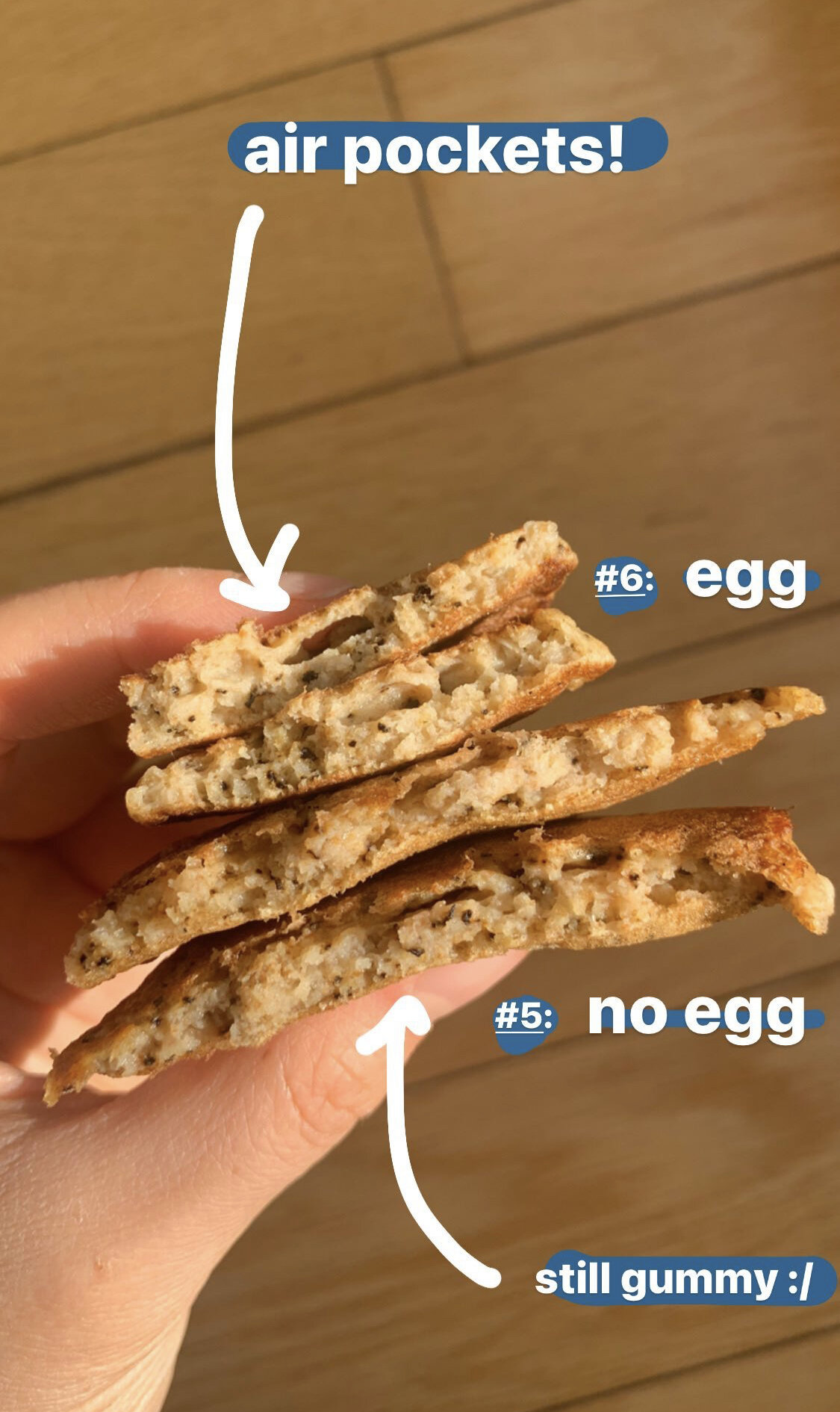earl grey, oat, & yogurt pancakes
“Let them eat pan-cakes.”
*Recipe has been revised as of April 6, 2024*
Time: 30 minutes
Servings: 2 servings, or 4-5 pancakes (about 4 inches in diameter)
Ingredients:
dry
¼ cup oat flour*
¼ cup all-purpose flour (see try experimenting with for substitutions)
½ tsp baking soda
½ tsp baking powder
½ tbsp white sugar
1 earl grey tea bag (or 2 tsp of loose leaf)
pinch of salt
*Simply blend rolled oats in blender until consistency resembles white flour.
wet
¼ cup dairy whole milk or plant-based yogurt
¼ cup milk, plant-based milk, or water
1 egg, yolk and whites separated
if vegan, use ½ tbsp neutral oil (e.g., grapeseed, canola, melted refined coconut, etc.)
butter or oil, to grease pan
to top if off: plant-based or dairy yogurt, maple syrup, berries, seeds
Recipe:
1. In one bowl, combine and whisk together all the dry ingredients.
2. In a separate bowl, combine the wet ingredients. It’ll take a little effort to thin out the yogurt into the milk, but just be patient.
3. Create a well in the dry ingredients. Pour wet ingredients (egg YOLK, yogurt, milk) into the well of dry ingredients. Whisk gently until only a few dry streaks remain.
Instead of a whisk, you can also use a fork.
4. Now, heat pan with oil/butter on medium heat. While the pan is heating, whisk egg whites until lightly frothy. Gently fold egg whites into the bowl. Frothy streaks should still remain.
5. Using the same ¼-cup measuring cup, add batter slowly into the pan from a height of no more than a few inches. This method will give you the most circular form.
6. Once edges are formed and bubbly, flip pancakes.
For crispy edges on both sides, you will want to add more oil/butter to the pan before you flip.
7. Once both sides are browned, remove from heat. Spread out pancakes on a plate or wire rack as far apart as possible from each other. If too close, pancakes will steam each other, and edges will not stay crispy.
8. Voila! Admire the height of your stack, and serve immediately with a dollop of yogurt, generous drizzle of maple syrup, and berries.
Non-negotiables:
Baking powder & baking soda — Yes, you need both; both will provide the rise for a thick pancake. Baking powder is activated by heat while baking soda is activated by acid (the yogurt).
Mixing — Throughout testing, I tried to combat chewiness--or forming too much gluten. Like most baked goods (i.e., cakes, muffins, etc.), pancakes are best when fluffy with a delicate crumb. Overmixing is the biggest culprit behind chewiness or a dense crumb.
Measuring — Since this recipe is in U.S. customary, not metric, it is important that you measure out the cups correctly. Do not dig your measuring spoon directly into the flour bag. Take a spoon, and scoop and transfer from the bag to your cup. Level the measuring cup by shaking it gently side-to-side.
1:1:1:1:1 ratio - I worked really hard to maintain easy-to-remember ratios for this recipe. You can use the same measuring spoon for oat flour: all-purpose flour: milk: yogurt. My hope is for all my recipes to become recipes you can easily remember—ones you can reach for off the top of your head when you don’t know what to make.
Dropping your batter slowly into the pan, no higher than a few inches -- This technique ensures thick and fluffy pancakes. Because you are carefully controlling the speed at which the batter hits the pan, the batter won’t spread out as much.
Try experimenting with:
Flour — I flirted with all different types of flours during recipe development, trying to groom this recipe to be substitution-friendly. My personal favorite is spelt: I had zero problems with gumminess/gluten overdevelopment, and spelt provides a milder taste than whole wheat.
Both spelt and wheat contain gluten, but spelt is an ancient grain while whole wheat is a modern grain. Since the industrial revolution, wheat has been hybridized and modified, so that modern and ancient grains now have entirely different types of gluten molecular make-up.
See Test #4 for AP sub (but I would NOT recommend AP). See Test #5, 6, 7, and 8 for whole wheat sub.
Teas — I’m sure this recipe would be lovely with any flavored black or green tea bags. But I cannot take any fault if you end up with pancakes that taste like dirt and leaves. I tested multiple brands of bagged earl grey (from Twinnings, English Tea Shoppe, Fortnum and Mason, to Kusimi), and they are yielded around the same amount of flavor from one tea bag.
Plant-based yogurt/milks — Whenever I use plant-based dairy alternatives, I try to match the ingredients as much as possible to avoid colluding flavors. For example, when testing with cashew yogurt, I would opt for cashew or oat milk (instead of almond milk) to match the yogurt and dairy alternative (cashew-cashew) or flour and dairy alternative (oat-oat). When I tested the recipe with almond yogurt, I opted for unsweetened almond milk to match yogurt and dairy alternative.
Scaling up - This is 2024 Alex speaking: I’ve scaled up this recipe for five, doubling all the quantities. I also think I lost my 1/4 measuring cup recently, so I tried the 1:1:1:1 ratio without changing the rest of the ingredients, using a 1/3 measuring cup, and it worked. Pancakes were slightly larger, but still served 2 people.
Vegan - if vegan: ½ tbsp neutral oil (e.g., grapeseed, canola, melted refined coconut, etc.)
Recipe Development:
Test #1, September 17, 2020: The first test wasn’t even a test, really. I was just making myself pancakes for breakfast. Pancakes that were a complete overkill, that is. I steeped a single tea bag in almond milk, blueberry compote, and in a cup of tea. Yes, the same tea bag.
The pancakes had no sign of earl grey unfortunately (most likely to the gentle steeping and strong buckwheat flavors). But the idea was there. I never know which recipes I should develop until I receive feedback. So, when I posted this earl grey^3 pancake breakfast and I got decent interest, the idea moved into recipe development.
What I did right: the ~idea~
Needs improvement: stronger earl grey flavor, fluffier pancakes
Test #2, October 3, 2020: Going forth, I decided to nix the buckwheat from this recipe. Buckwheat pancakes are truly my favorite kind of pancakes, but since flour is so dark and flavor is so strong, the earl grey was never going to come through (in crumb or flavor). I replaced the buckwheat with whole wheat. Instead, I derived inspiration from Molly Baz’ infamous Earl Grey Yogurt Tea Cake and a King Arthur Baking Oat and Yogurt Pancake. (I tried making Molly Baz’ cake during phase 1 of quarantine, and I didn’t have success with it. I blame myself for this failure because I subbed 1:1 BRM gf flour. Why? 1) At this point of the year, I think I was still mending my relationship with carbs. 2) Personally, I think loaf cakes are one of the baked goods that you can get away with gf flours.)
What I did right: The earl grey flavor came through this time because I used the actual tea leaves instead of just steeped milk. Nixing the buckwheat flour also helped on three counts: 1) earl grey flavor 2) distinguishable earl grey crumb 3) lighter, fluffier pancakes. The acidity of the cashew yogurt also activated the baking soda and counteracted the sweet maple syrup with a tang.
Needs improvement: The pancakes were really gummy. Gumminess can origin from four causes: 1) Because I switched from buckwheat to whole wheat, I introduced gluten into the recipe. 2) I’m the #1 offender of overmixing, so I probably developed too much gluten. 3) I think the flax egg binder also contributed to the gumminess in the recipe. 4) Too much flour, not enough liquid.

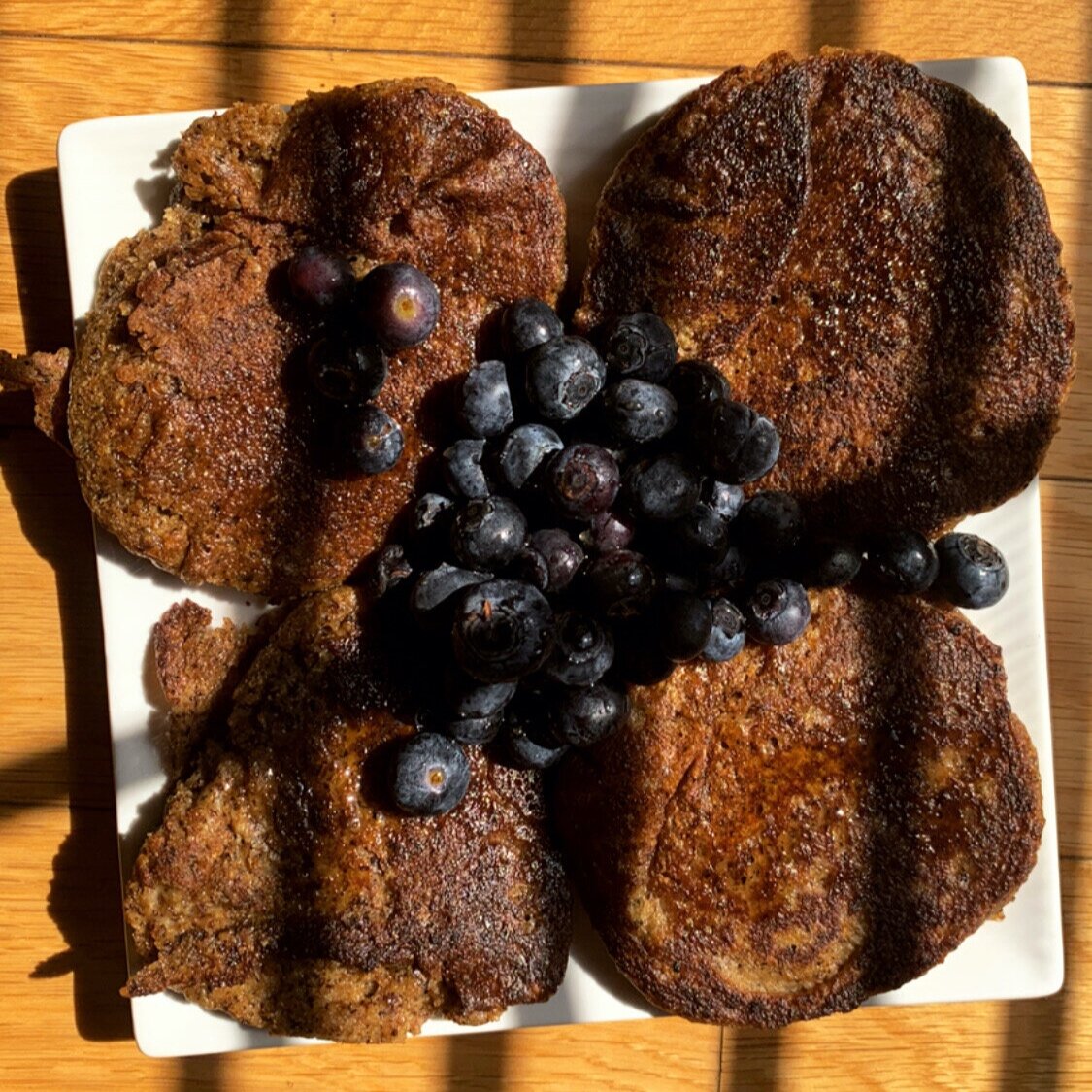

Research #1: I looked into dry:wet ratios of pancake batters. For too long, I’ve bamboozled by the wellness sphere’s “healthy blender pancakes” or “2-ingredient banana egg protein pancakes,” so I realized I wasn’t actually sure if I knew what the correct consistency of pancakes should be. After scrolling through countless recipes, I read that traditional recipes seemed to call for the wet ingredients to exceed the dry ingredients by 25-30% (¼ to ⅓ cup). I also read that many vegan recipes actually do not substitute anything for egg.
Test #3, October 17, 2020: This test was all about combating gumminess. I attacked gumminess on all four fronts: 1) switching flour 2) avoid overmixing 3) getting rid of flax egg 4) increasing liquid by 25%. I opted for spelt flour because I actually prefer its more mild taste, and spelt flour has an different gluten composition than modern wheat flours.
What I did right: No gumminess at all!
Needs improvement: I have a theory that the first couple pancakes you cook are always the worst. Because this single-serving recipe only makes 4 pancakes, that means ½ of the pancakes are less-than-perfect. I needed to refine my cooking technique. I think the heat was too high, and I don’t really remember seeing bubbles.
Also, I understand spelt is more of a specialty flour in the U.S., so in order to make this recipe more accessible, I wanted to test the all-purpose and whole wheat substitutions.

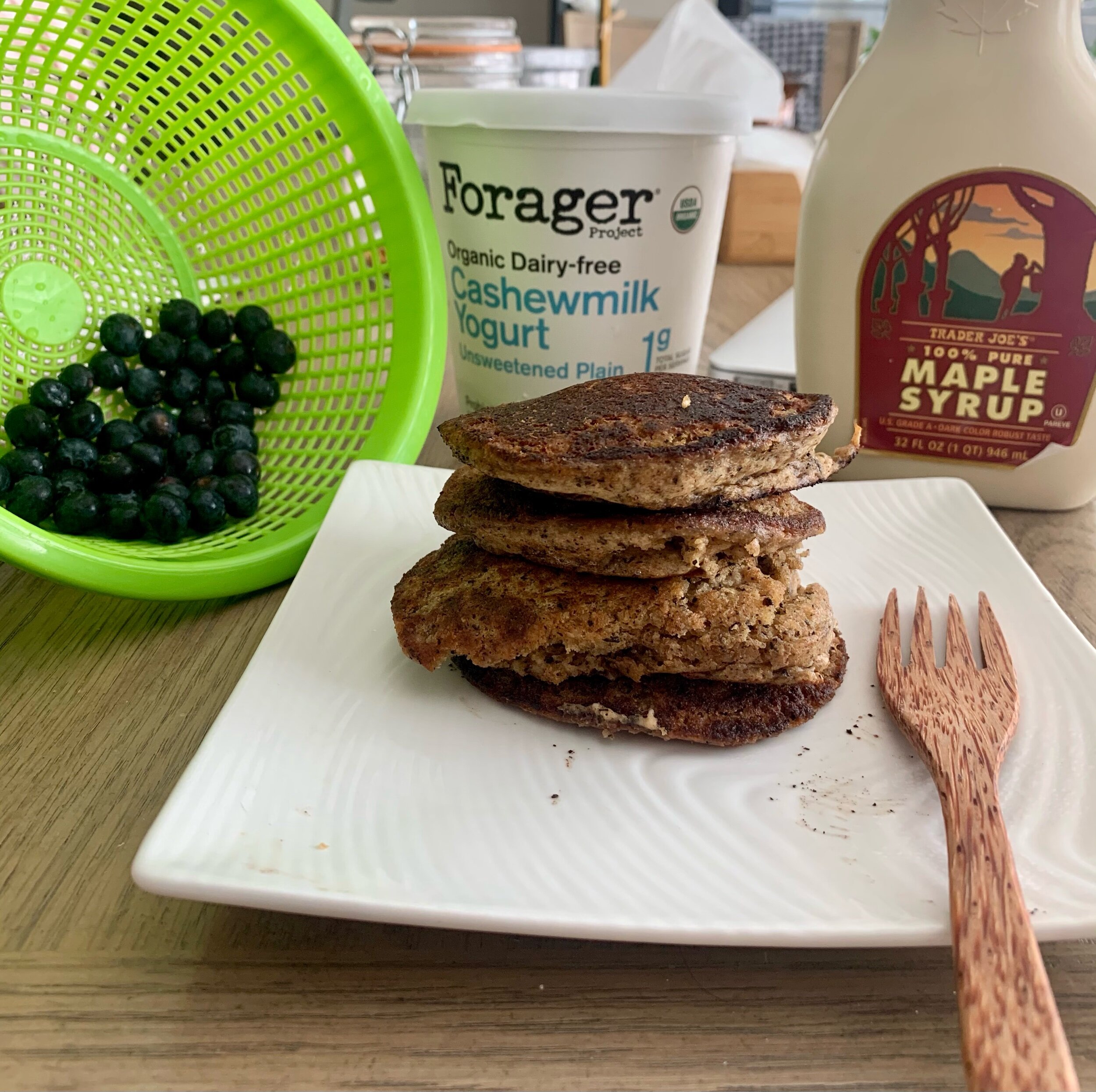
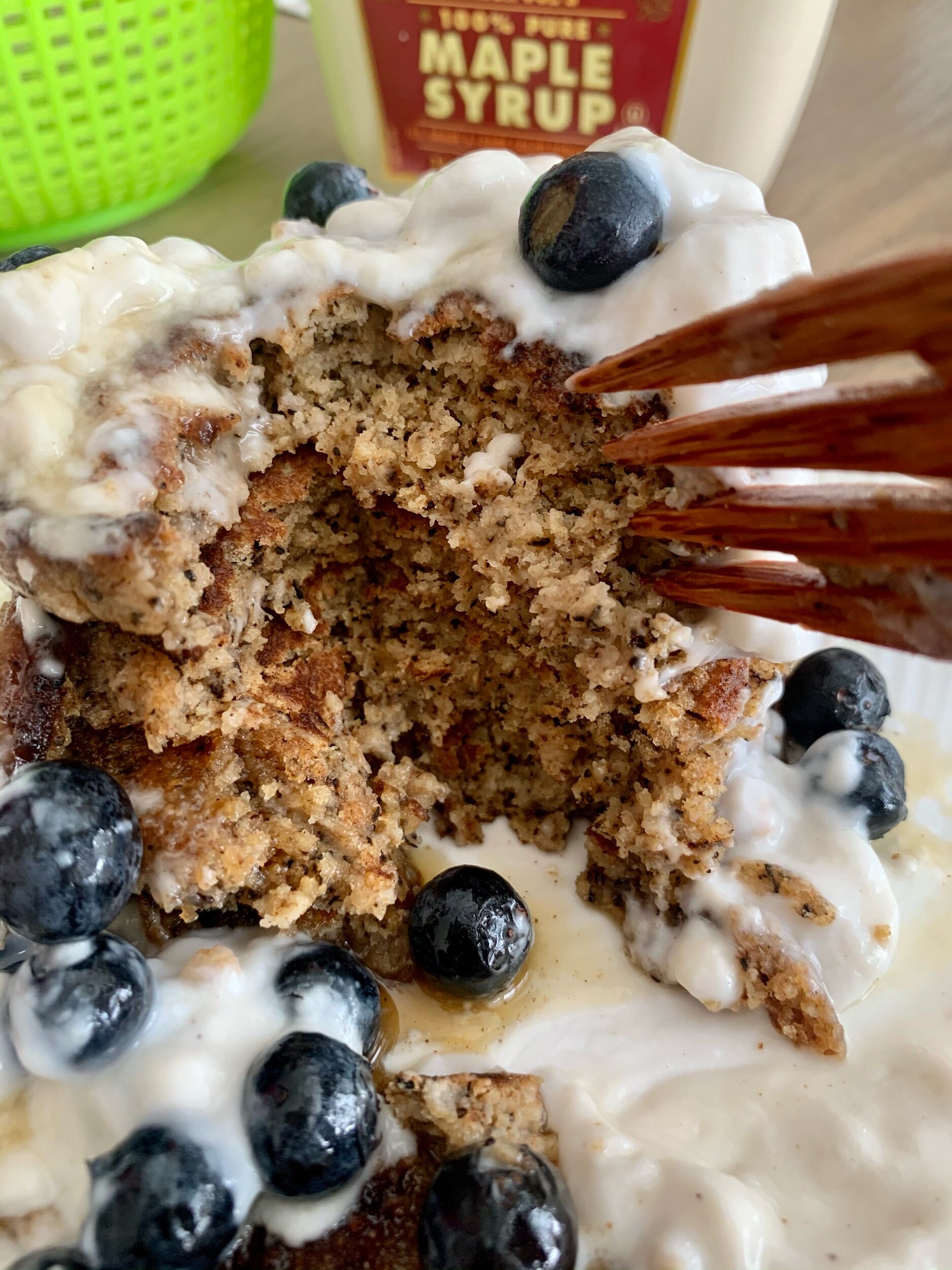
Research #2: I was able to get my hands on a copy of Claire Saffitz’ Dessert Person, and reading through her loaf cake recipes, I was reminded of a classic cake-mixing technique. In order to prevent overmixing, it is recommended to pour wet ingredients into a well of dry ingredients and then whisk.
Test #4, November 22, 2020: I used all-purpose pastry flour in this test. Pastry flour has even a lower protein content than regular all-purpose (8-9% vs. 10-11%). Modern whole wheat ranks somewhere around 13-14%. Lower protein content should develop less gluten.
What I did right: As expected, because all-purpose is the most neutral flour, earl grey flavor was even more pronounced. AP is also lighter in color, so the earl grey flecks were more apparent. The batter fluffed up well because AP is not as heavy as WW. It does not contain the whole grain.
Needs improvement: I would NOT recommend using AP in this recipe. The pancakes were difficult to flip. Because it does not contain the whole kernel, AP soaks up less water: the liquid:dry ratio was off from the start. Even though I used pastry AP, these pancakes were oddly gummy. Because AP does not provide a nuttiness that WW does, the cakes also felt too sweet.
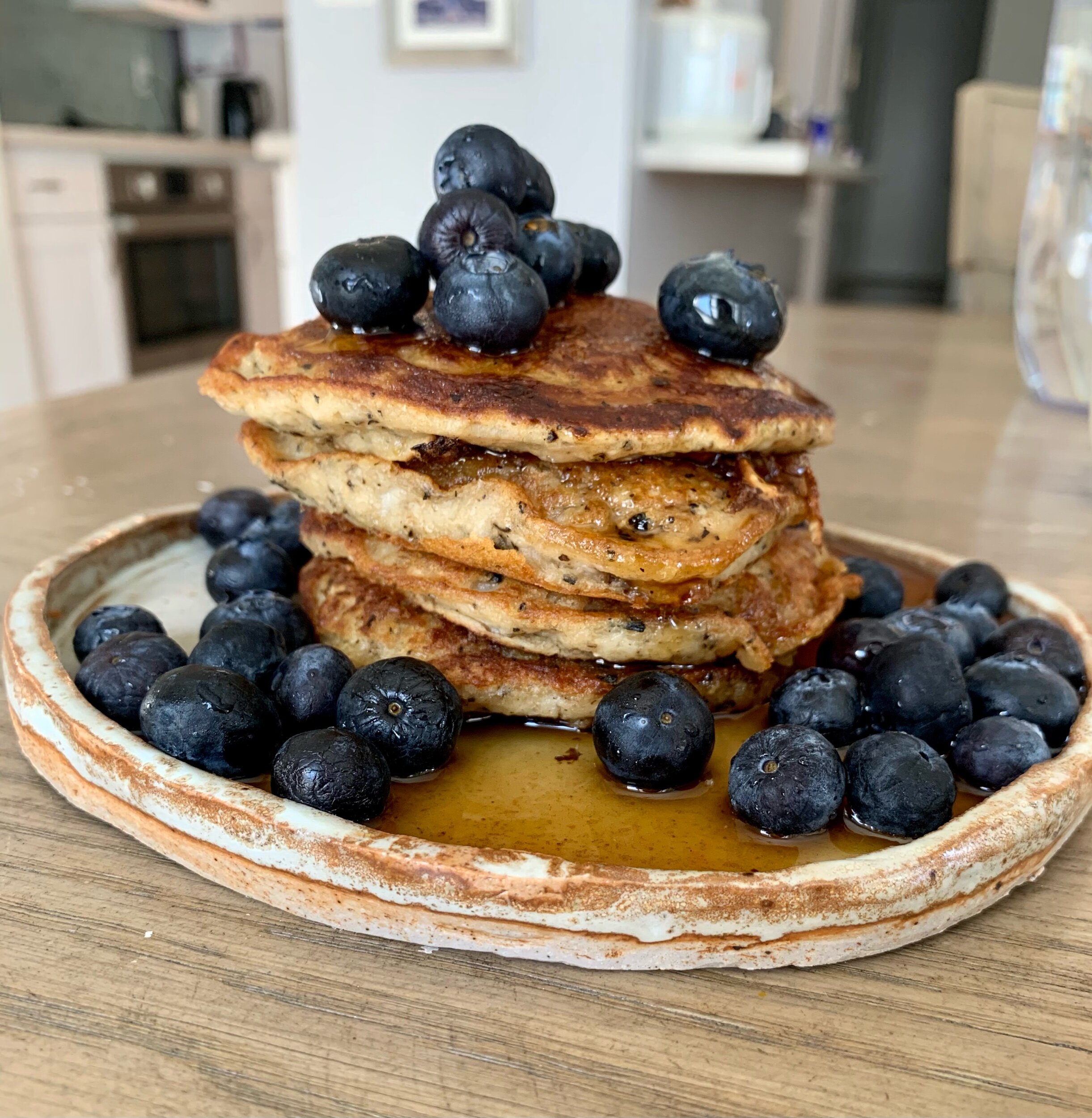

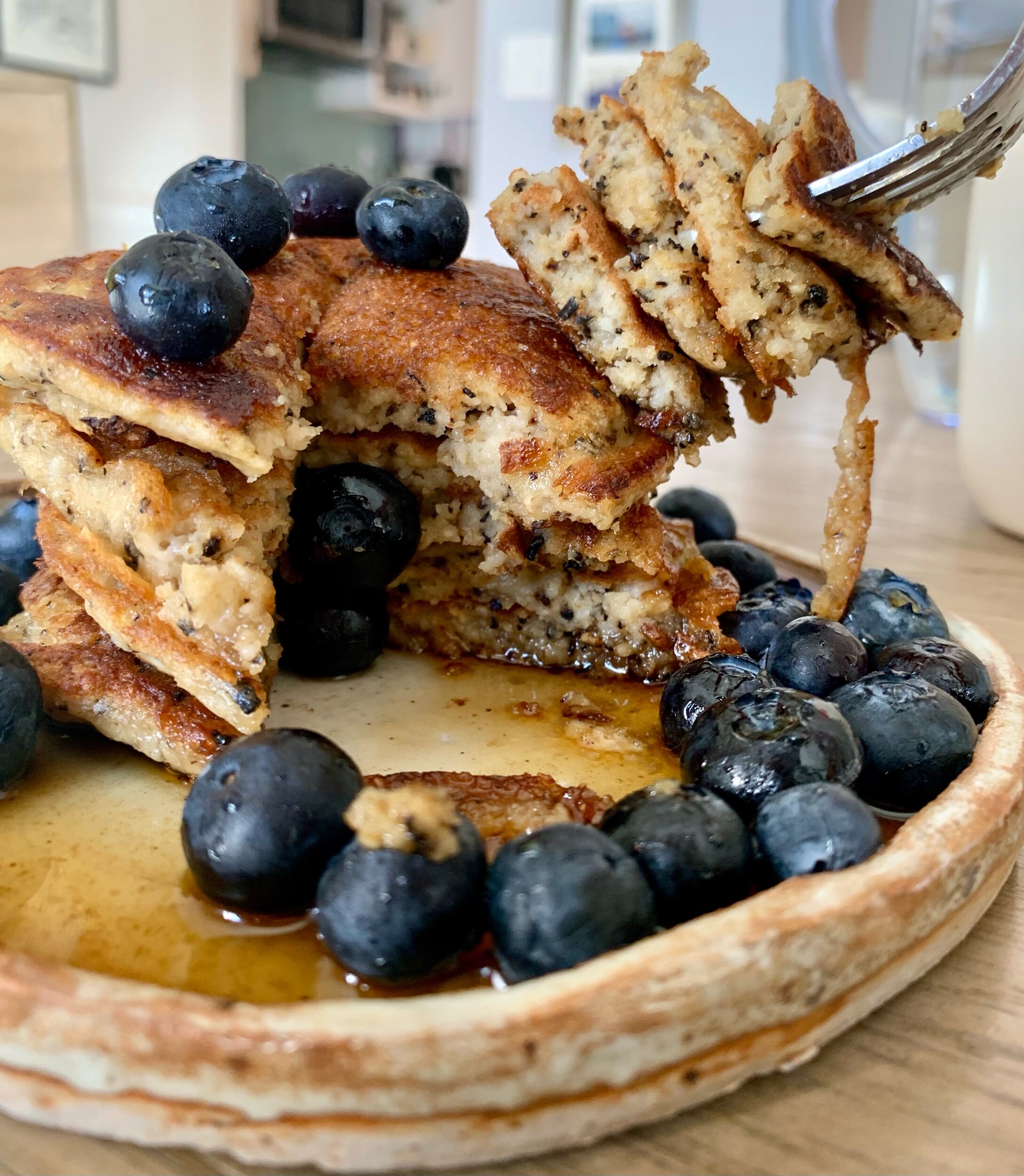
Test #5 & 6, December 5, 2020: I was a bit traumatized at how much of a setback using AP was, so I moved back to WW. In test #2, I used WW, but I also used flax egg. Since at this point I completely eliminated flax egg from the recipe, I wanted to introduce WW back. While I am plant-based, I am not vegan: so, I did want to do a non-vegan iteration. Long story short, I did two tests. Was it chaotic? Yes. Is it ever not chaotic though? No.
Test #5 was still vegan but this time with WW and whipped aquafaba. I probably should have only made one change--that is, introducing WW back and not using aquafaba, but I already told you that it was chaotic. Because whipped aquafaba is commonly used as a whipped egg white substitute, I thought it would give the batter an extra rise with the heavier WW flour. I gently incorporated 2 tbsp of softly whipped aquafaba right before the pan. I thought 2 tbsp would be equivalent to 1 egg. I also used unsweetened almond yogurt for the first time. Previously, I was having a moment with cashew yogurt.
Test #6 introduced WW and a real egg into the recipe. I would have also liked to use dairy yogurt. But I simply did not have any in the fridge, so I used the same almond yogurt. I recently discovered The Pancake Princess’ baking blog: in one day, she tests nine different recipes of the same dish (mostly baked goods) and then invites her friends over to taste test all the takes. I admire her very scientific and data-driven approach: she notes discrepancies in ingredients and techniques and averages her taster’s rankings. I read over her buttermilk pancake blog post, and one of her biggest takeaways was separating the egg yolk from egg white. While whipping egg whites did not make a noticeable effect, she wrote that separation made a noticeable difference in fluffiness. I took her word of advice.
What I did right: While testing two iterations at once was chaotic, I think it turned out for the best. I could directly compare the batter consistency, cooking technique and time, and taste at the same time. The only difference between the two was one included a whipped aquafaba egg while the other included a real egg. They both fluffed up equally on the pan. But Test #5 fell after removed from the heat while Test #6’s did not fall. The egg ultimately provided structure, stabilizing the rise. Egg also provides a barrier between gluten molecules to deter gluten formation. Test #6 was not gummy at all. In a direct taste comparison, test #5 had a stronger earl grey flavor while test #6 was unsurprisingly more eggy.
Needs improvement: Test #5 had a very uneven mouthfeel. Patches towards the center were cake-like while patches near the edges were more chewy. This makes sense: as building bigger air pockets stabilized by gluten bonds (not too strong bonds though) ultimately prevents gumminess, the thinner edges would not have achieved the same open crumb. I was hoping the whipped aquafaba would aerate the batter and provide a barrier between gluten molecules, but it did not.
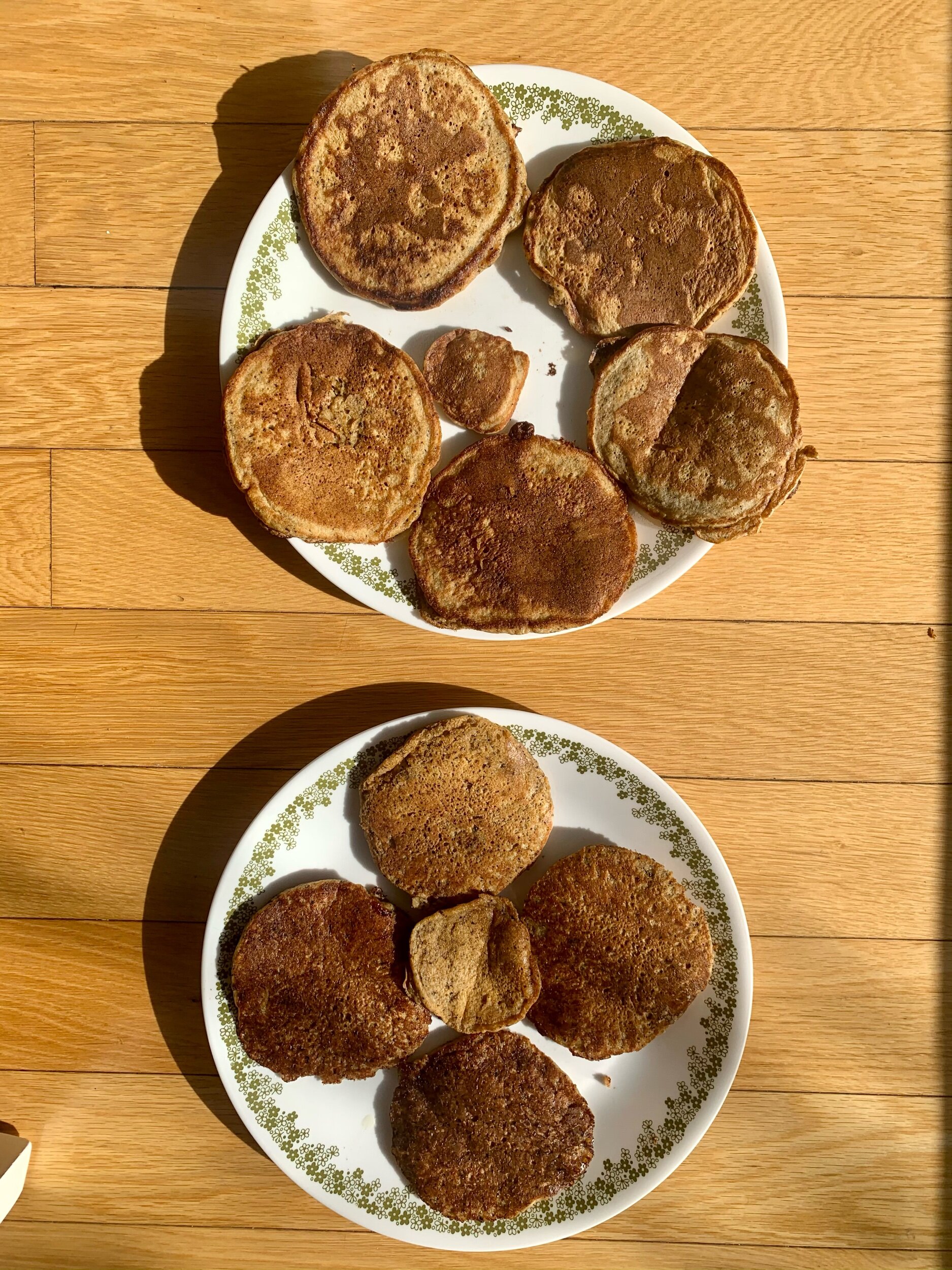
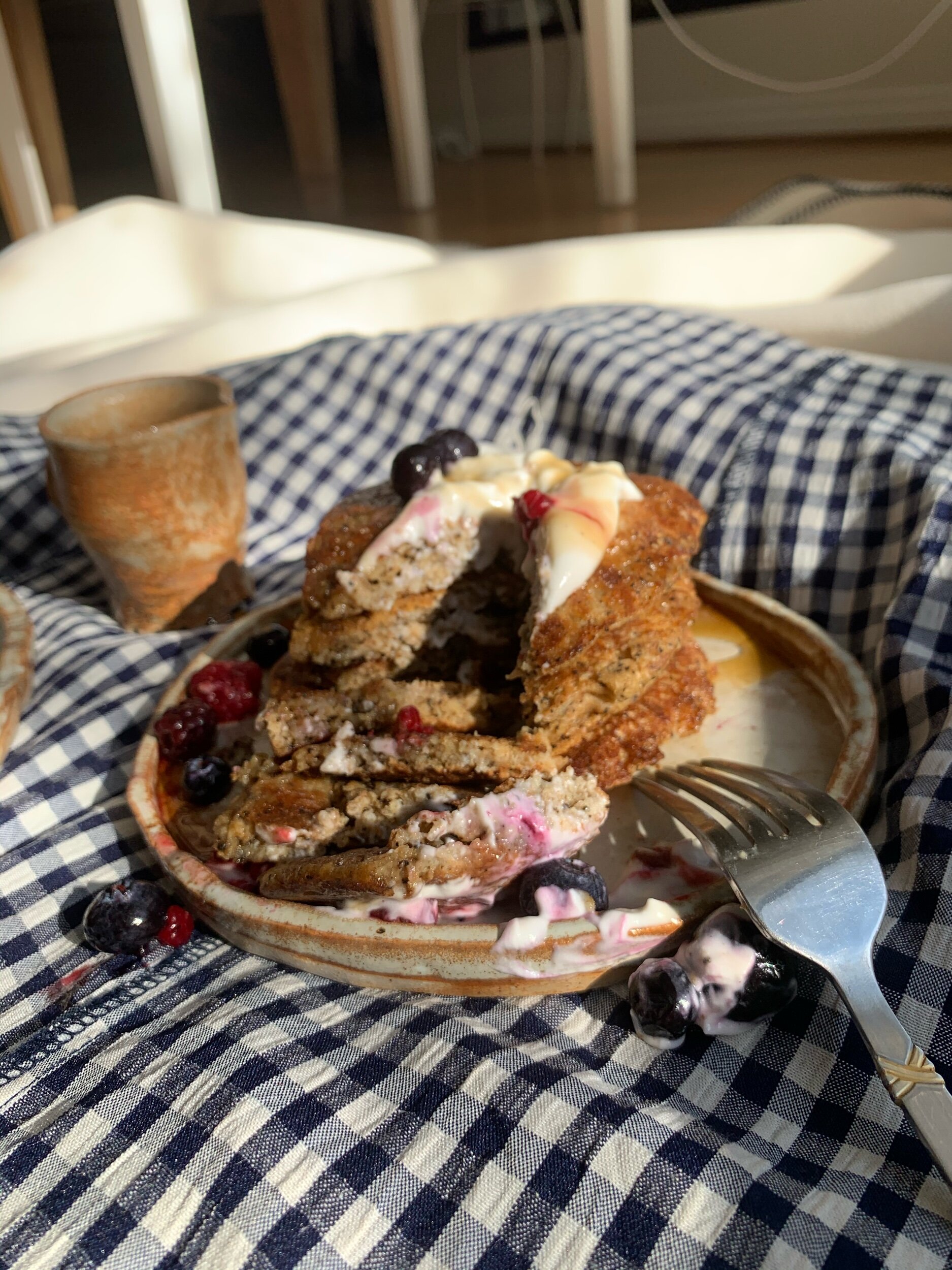


Test #7 and #8, December 20, 2020: Tests #5 and #6 proved that I needed to add a fat source to enrich the batter and barr gluten formation. Previously, I thought the nut-based yogurt would provide enough fat, but apparently it did not. This time, I wanted to try adding ½ tbsp of oil to the vegan batter. I frankly was a little tired of this recipe four months in, so I outsourced to my friend and vegan baking whiz Christine @c.rice.tine to test the vegan recipe. Christine returned with not only one but TWO tests. #7 was identical to my vegan recipe-to-date. In test #7, she also found that the edges tapered out. In test #8, she tried adding ½ tbsp of oil, and the edges evened out! The pancakes did not fall. She also decreased the liquid to ¼ cup. She noted that thickening the batter prevented the pancakes from spreading out on the pan. In both tests, she used a sweetened, vanilla almond-based yogurt.
What she did right: Christine perfected the vegan recipe, adding ½ tbsp coconut oil and decreasing liquid by ¼ cup. Christine noted
Needs improvement: Vegan recipe is ready to go!
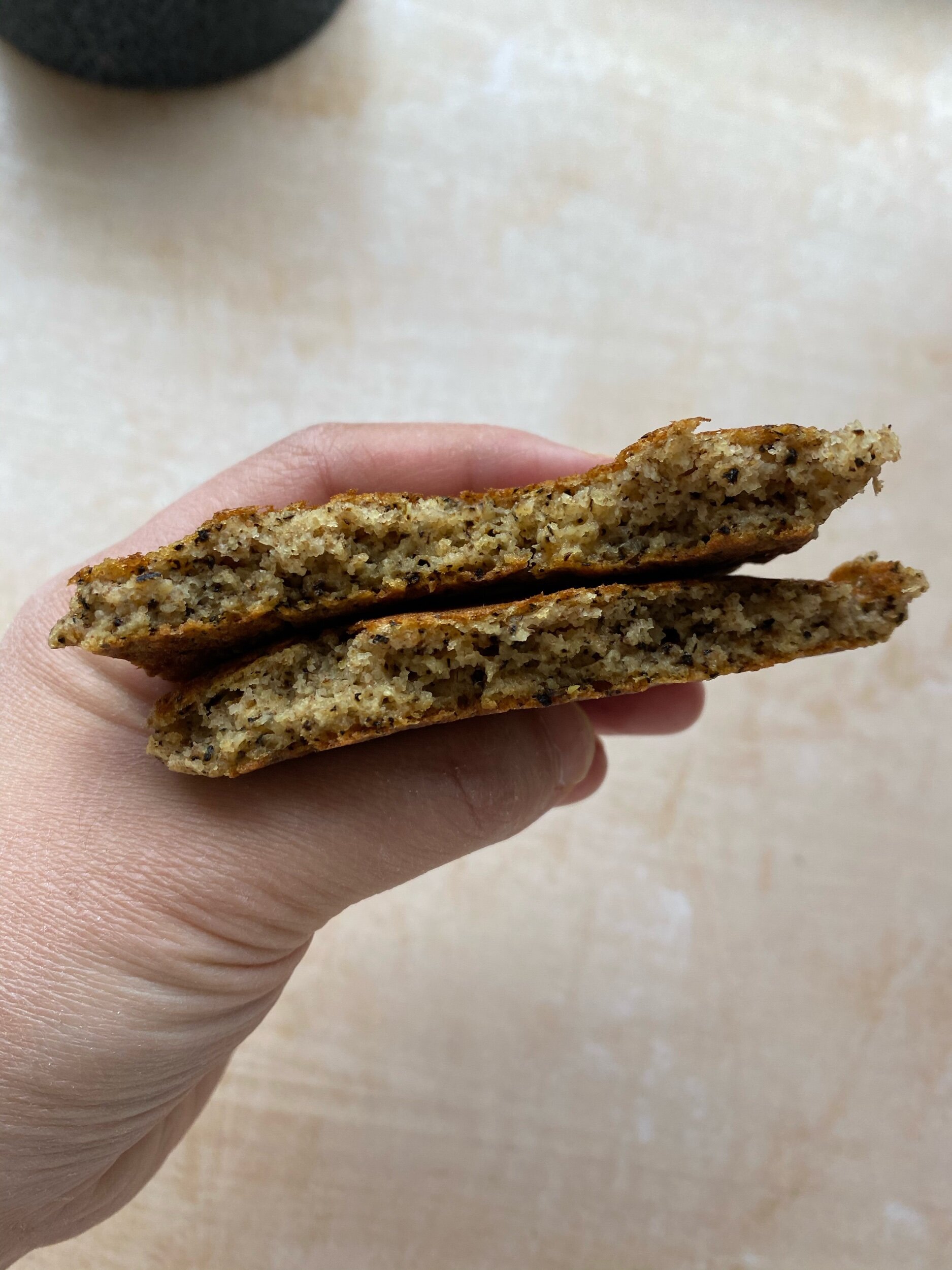
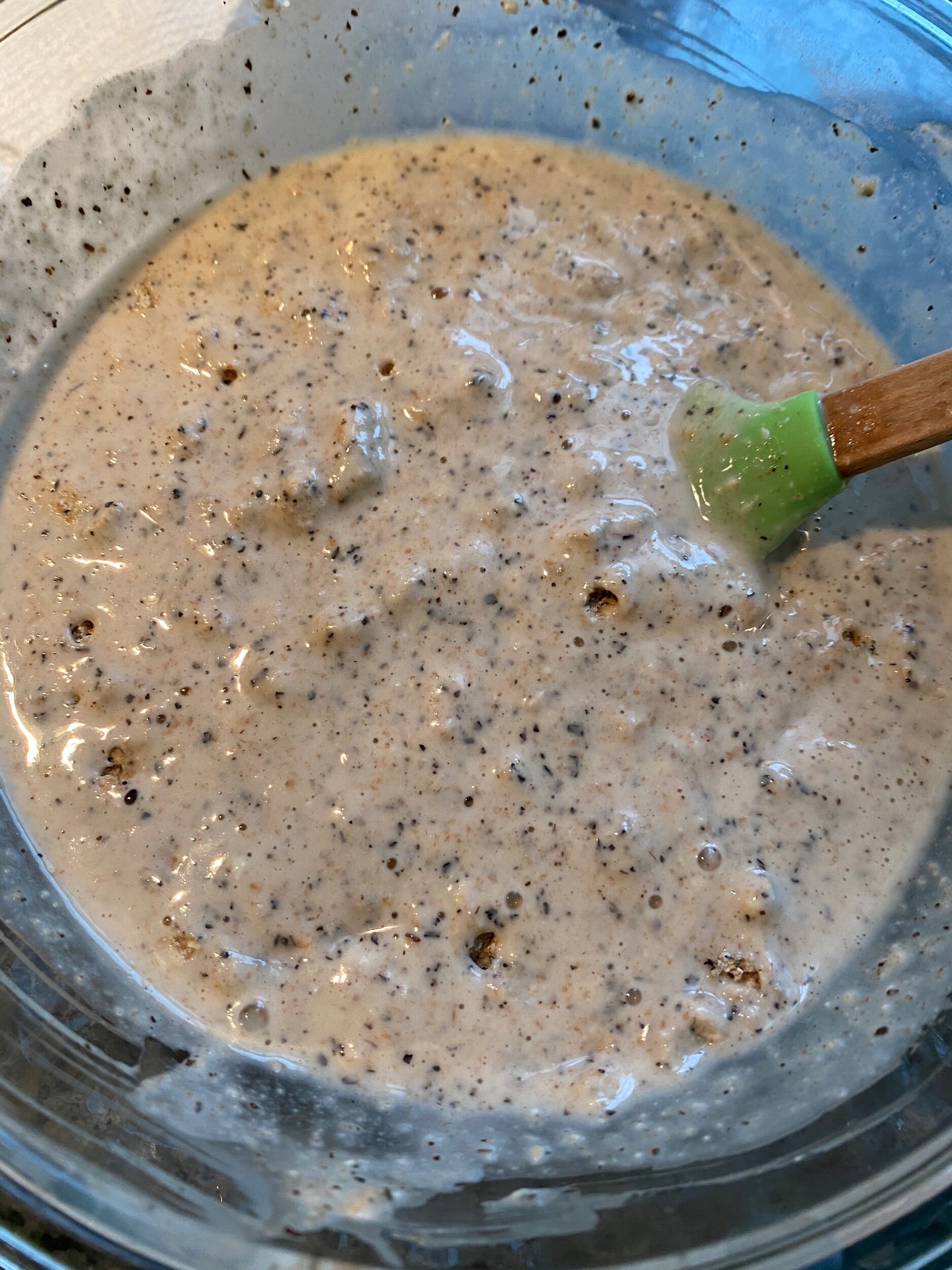

Test #9, December 20, 2020: Christine texted me on a Sunday morning EST...just in time for me to prepare breakfast for myself on a Sunday morning PST. After seeing her nail the vegan version, I was reenergized. I decided to test the non-vegan version one more time. In test #6, I only reintroduced an egg, but I wanted to substitute in dairy yogurt as well this time. I used the best whole milk yogurt: Straus Creamery European Style. (Thank you to my friend Rachel @xoxo.glutengirl for putting me on this yogurt early in quarantine. It is the only yogurt that does not give us both stomachaches.) As Christine noted, I also decreased the liquid by ¼ cup. Lastly, I went back to spelt flour.
What I did right: I did not notice a difference in taste between plant-based vs dairy yogurt. But there was a big difference in structure. These pancakes were fluffier and easiest-to-flip! (Remind me why I ever decided to spend so much time veganizing these. These would have been done in two tests if they were not vegan.) In test #6, I was worried that the earl grey flavor was a little muted due to the strong egg taste. But in this test, the creamy tang of dairy yogurt must have toned down egginess so that the earl grey was more distinguishable. If you are not vegan, I would recommend using real eggs and dairy yogurt for the best experience.
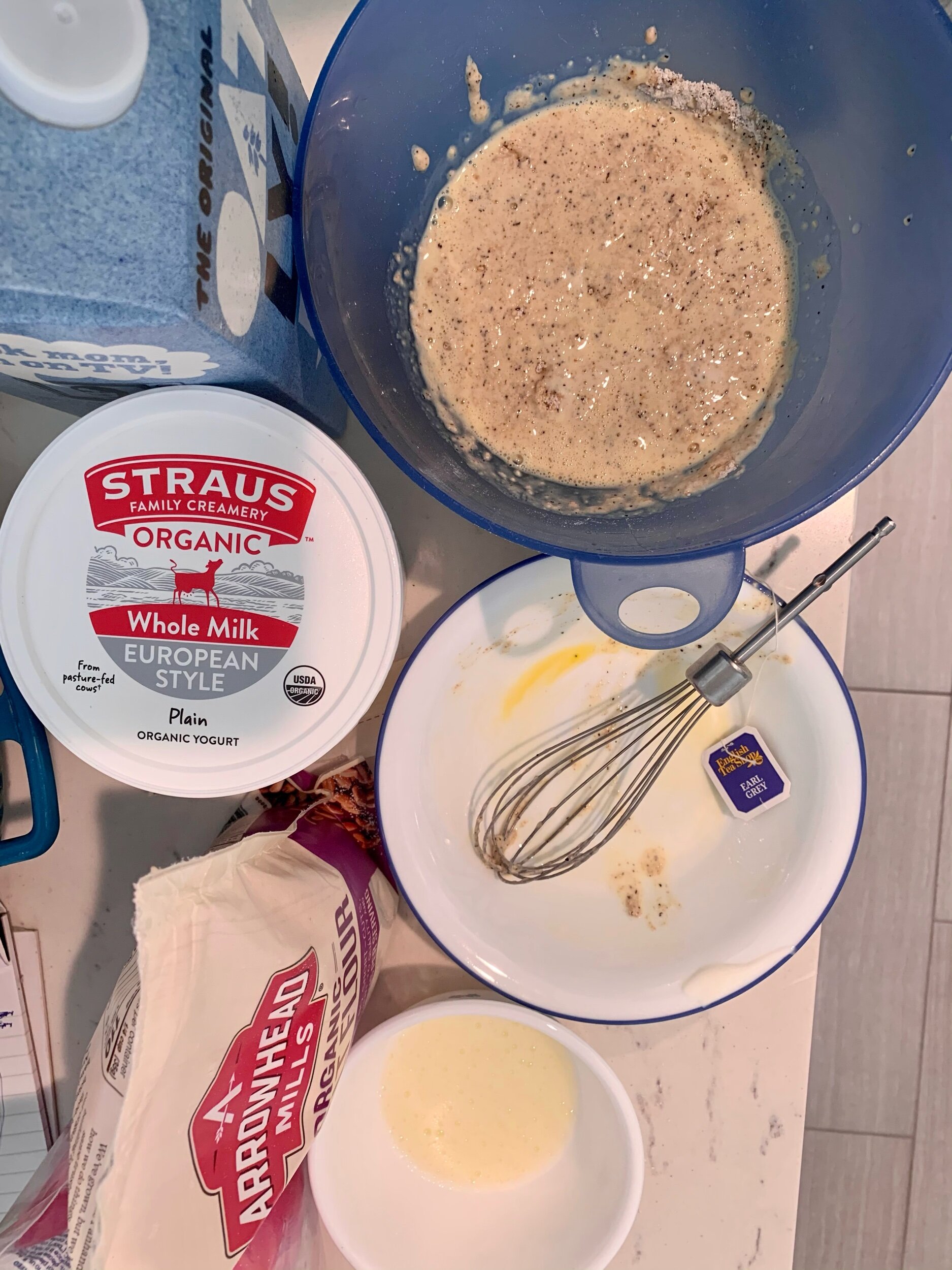
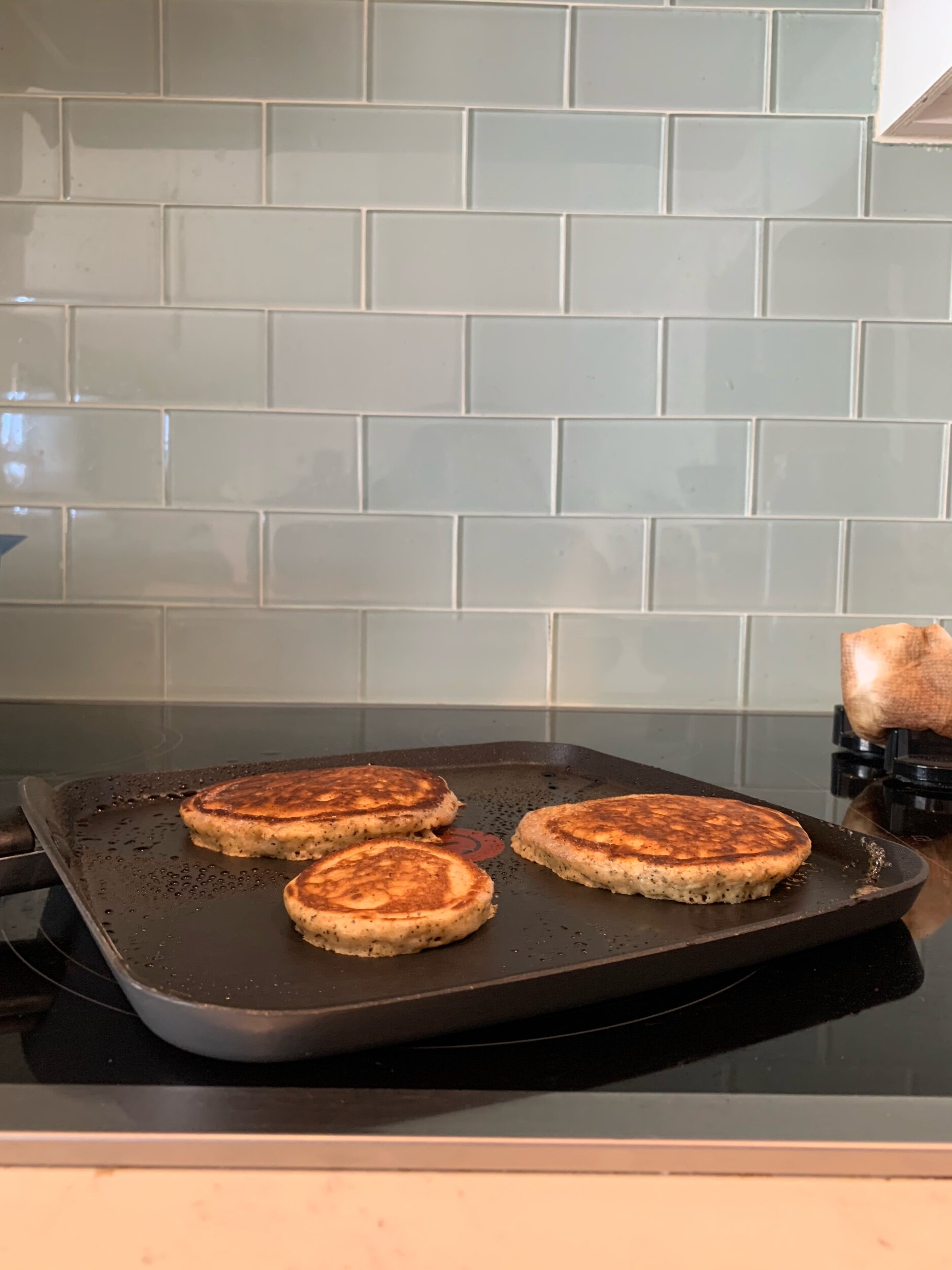
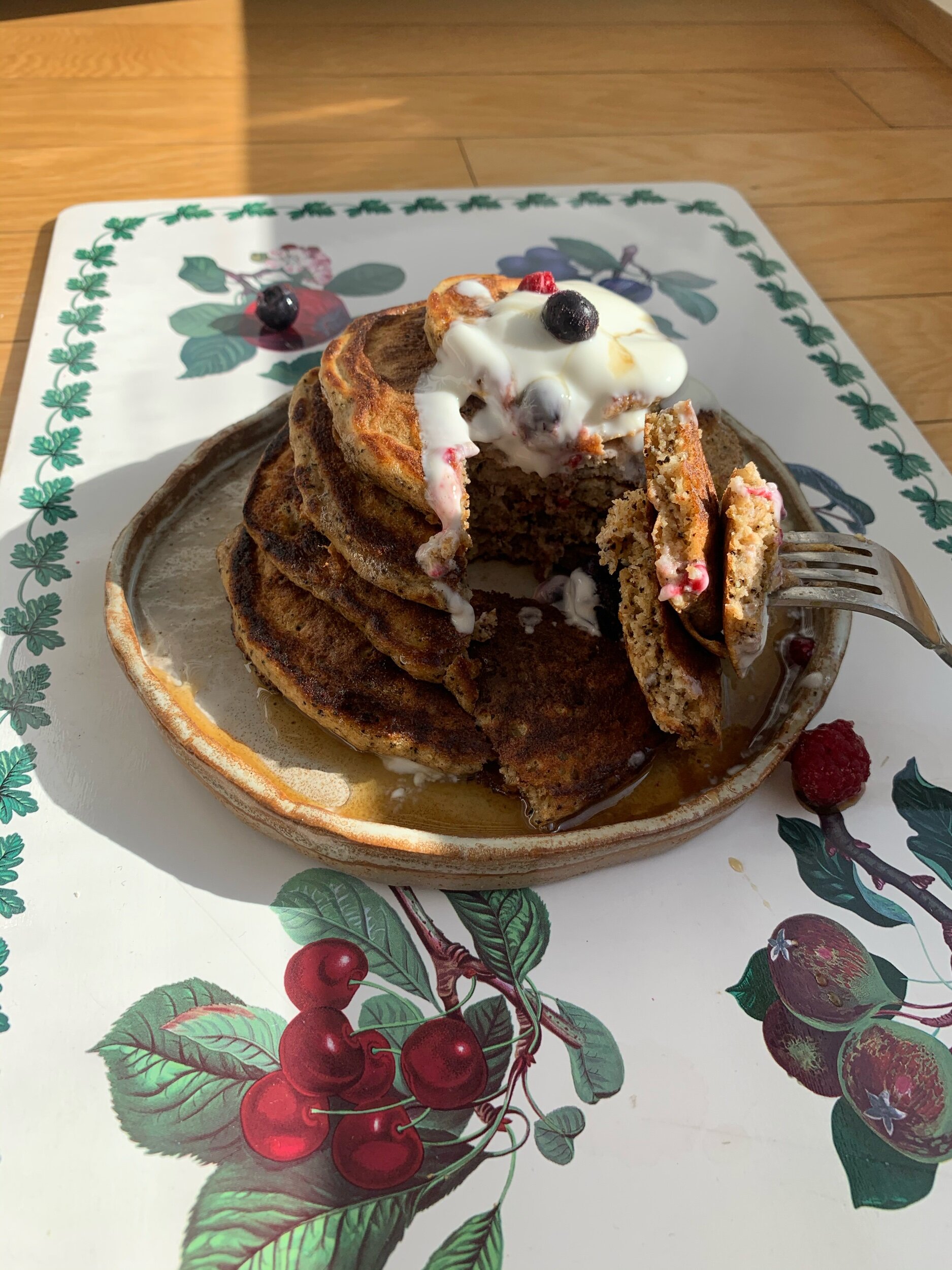
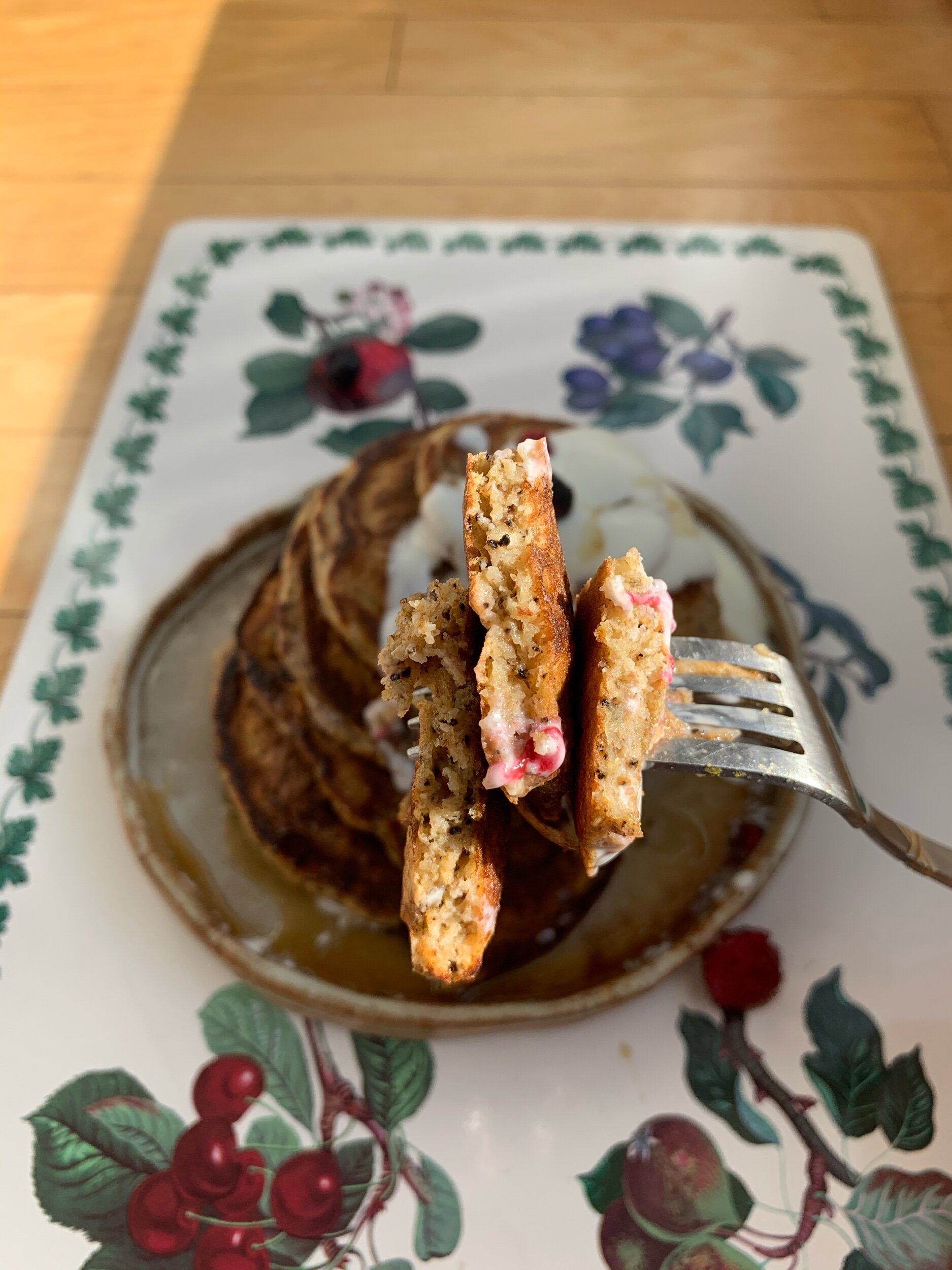
If you decide to test these pancakes, please tag me @everythingalexcooks,
(and I mean actually tag me, the new IG update doesn’t notify me when I simply get mentioned in a caption).
I want to see your creations and hear your thoughts!

